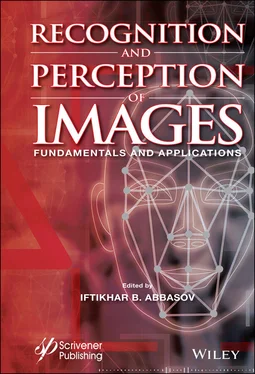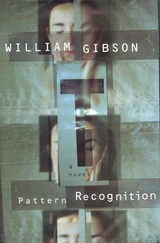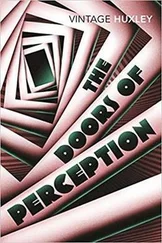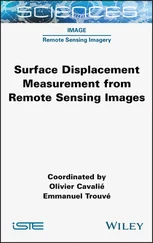
Figure 1.4.2 Linear perspective.
1.4.2 Monocular Motion Parallax
Monocular motion parallax (from the Greek word paralaxis – change) is a monocular source of information about the depth and relative position of objects in view, resulting from the movement of an observer or objects. When the observer fixes his gaze on some point of the field of view, and at this time he moves, it begins to seem to him that objects lying closer to the fixation point move faster than more distant objects. During the movement of the head, the images of objects in remote locations on the retina will be mixed at different distances. It seems to the observer that more closely spaced objects move in the direction opposite to the direction of eye movement, and more distant objects move in the same direction [Shiffman, 2008], [Abbasov, 2019].
For the perception of primary visual information, monocular signs of space play an important role. However, to accurately determine the depth of space requires the activity of both eyes. Binocular signs are spatial information that can only be obtained by perceiving the surroundings with both eyes.
Binocular disparity. Animals with a frontal arrangement of eyes (predators, primates) see a large part of the visual field with both eyes. Within the area of binocular overlap, two eyes receive slightly different images of the same three-dimensional visual information. The field of view of one eye is somewhat different from the field of view of the other. This difference between the two retinal images is called binocular disparity (binocular parallax). Disparity is strongly pronounced for closely located objects, and decreases as they are removed. After four meters, the difference between retinal images becomes insignificant, and binocular disparity weakens.
1.4.4 Binocular Disparity and Stereopsis
Due to the binocular disparity of the images on the retina of both eyes, there arises a special perception of the depth of space and volume, which is called stereoscopic vision, or stereopsis (from the Greek Stereos – volumetric and opsis – vision) [Luria, 2006], [Shiffman, 2008], [Abbasov, 2016]. One of the most impressive examples of stereoscopic vision is the perception of the effect of depth when viewing slides with a stereoscope, that is, when presenting each eye with slightly different planar images of the same scene, called stereograms, the illusion of volume.
Stereograms can also be created with a random set of black and white elements. Meaningful perception of the depth of these stereograms is possible only after the two images are combined in a certain central visual zone. When viewed with a monocular, these images lose depth and are perceived as uniformly arranged random elements. A special form of a stereogram containing two combined patterns for both eyes is called an autostereogram. An autostereogram is an unusual and difficult task for the visual system, since it is necessary to focus the eyes at a distance different from the one on which the drawing itself is located. But if you look with two eyes and do not suffer from stereo-blindness, then with a certain training session (and patience) you can see the stereoscopic image.
Illusion is a false or distorted perception of a phenomenon. Visual (optical) illusions arise when the visual perception does not correspond to the physical, real properties of an external stimulus. Illusions can be considered distorted perception of the surrounding reality, and thus differ from hallucinations, which are a false perception that occurs in the absence of external conditionality. According to the mechanism of occurrence, visual illusions can be divided into the following types:
– arising from the imperfection of the optical properties of the eye;
– resulting from the action of the entire visual system, including the brain;
– dynamic illusions arising from a change in the position of the stimulus in space or in time.
The survey of [King et al. , 2017] is dedicated to the analysis of distortions of perceiving the visual illusions in case of confusional insanity. People suffering from confusional insanity may experience the anomalies at the different stages of processing of visual information. Generally, such people are unperceptive to the illusions of high level. Moreover, they may be influenced by some illusions of initial stage.
Let’s consider the illusion of “Hollow mask” [Website youtube.com, 2020] taken as an example. The mask is turned both clockwise and counterclockwise upon view (the successive steps are shown in Figure 1.5.1). In fact, the mask is turned one way. However, for the majority of observers the mask changes the direction of movement at some point of time. At the start of movement the convex front side of the mask doesn’t make a difficulty for the visual system and consciousness. When the mask begins to move toward the back side (the backing may be observed through the hollow eye pits) our brain turns it out because the convex side is more familiar for us. We didn’t use to see people with concave faces. In the course of further turning the brain turns out and restores the usual convex form of the mask at the crossing line once again. However, the brain of scizophrene cannot be deceived; that’s why the mask is still hollow for it after turning.
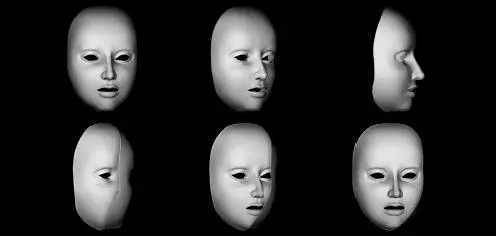
Figure 1.5.1 Sequenced frames of illusion of ‘Hollow mask’ [Website youtube.com, 2020].
It is necessary to admit that visual illusion doesn’t have the same effect on some people who are under the influence of alcohol and narcotics. The initially given illusion was found out in the case of hollow mask of famous actor Charlie Chaplin. The inversion of reality and processing of visual information belong to the functioning properties of the brain of a healthy man. The study of principles of brain activity is a quite difficult field. There are no definitive explanations even to this date. What is more real – the perception of real-world view by the brain of scizophrene (without processing) or the visual information processed by the brain of a healthy man?
1.5.1 Constancy Perception
As a result of evolution, our sensory system has adapted to an adequate perception of objects and phenomena of the surrounding world [Arnheim, 1974], [Shiffman, 2008], [Abbasov, 2019]. In the process of perception, surrounding objects are characterized by some relatively stable physical properties. Perceptual stability when changing parameters of physical stimulation is called perception constancy.
Constant Perception of Lightness
The brightness of the surface of objects is characterized by the intensity of the light reflected by it, or luminosity. When the light intensity changes, the degree of lightness of a sheet of white paper practically does not change, despite the change in luminosity. It will also be perceived as white paper, but with less brightness.
Constancy Perception of Size
The tendency to perceive the size of objects unchanged relative to the observer (the size of the projection on the retina) is a consequence of the constancy of the perception of size. As follows from Figure 1.5.2, a person sitting at the end of the corridor is perceived to be the same size as the one sitting in the foreground, although the size of the retinal image on the retina is several times smaller [Website istockphoto, 2020]. If you place the images next to each other, you can visually detect the resizing of seated human figures.
Читать дальше
